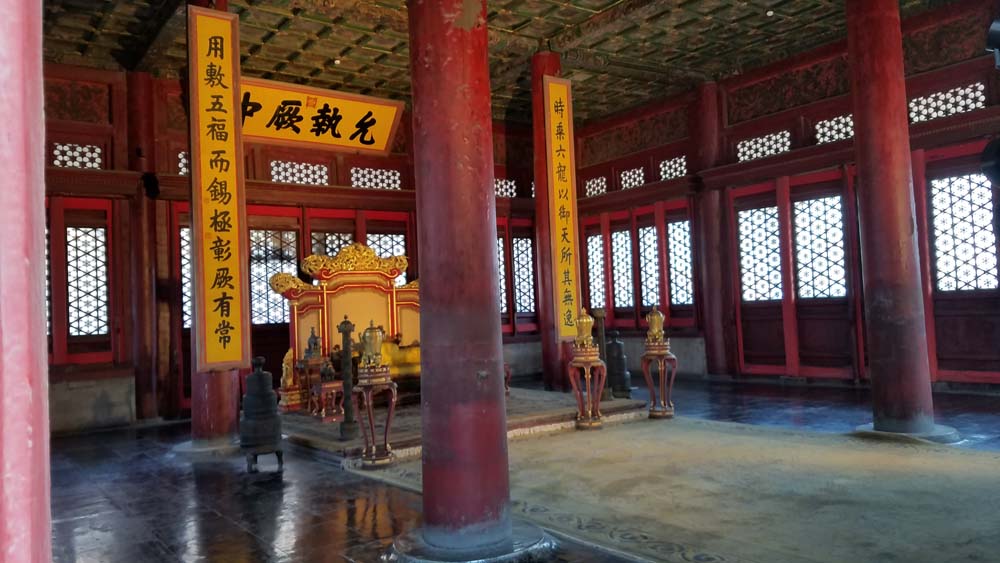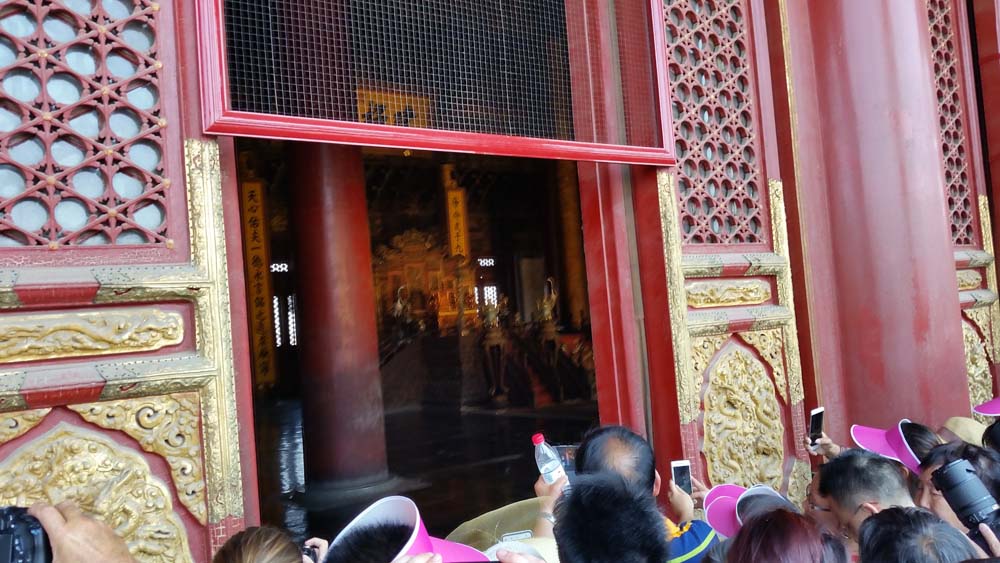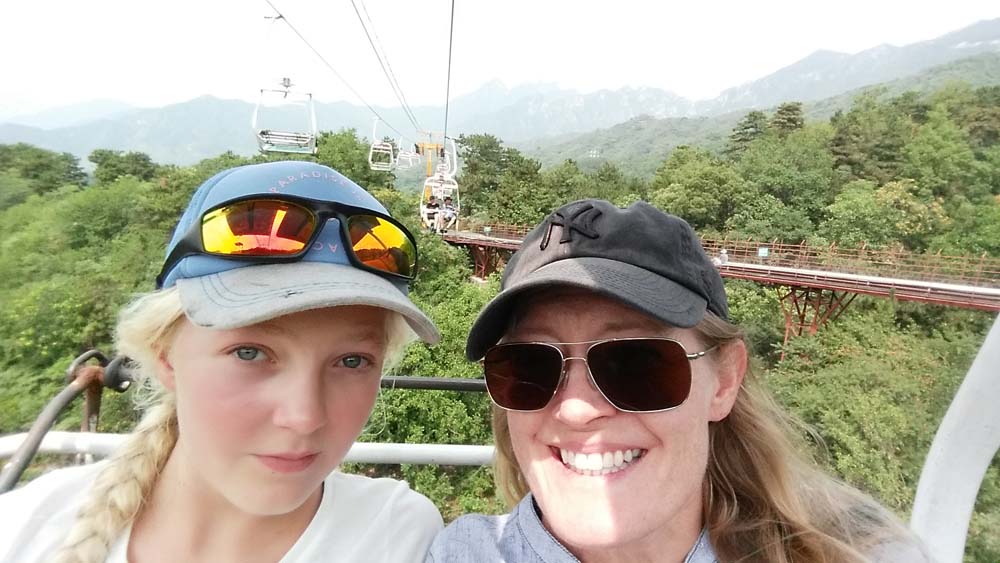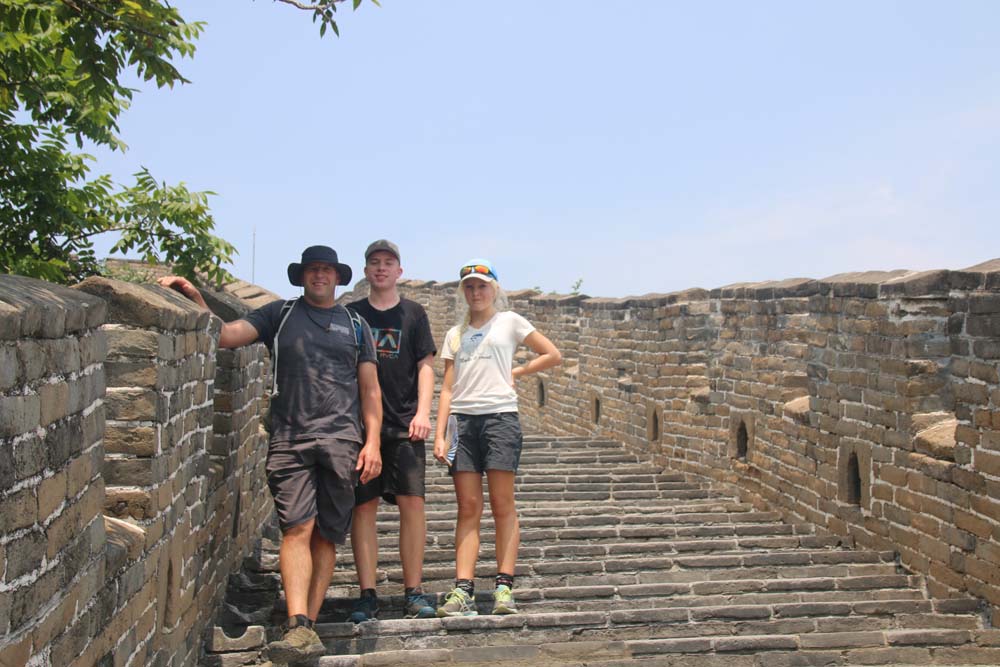 Adventuriety
Adventuriety
China was a big deal for a lot of reasons. It was our 6th continent, our 18th country and our last destination for the year and above all, it was China and the thought of China intimidated me. Of all of the countries we have visited in the past year, China seemed the most foreign to me with its language, history, size, government and current political relationships. Even the visa application was intense. Because we were not going with a group, only a guide, we each needed a visa attached to our passport requiring a last second trip to Los Angeles and the Chinese Embassy because we were lazy in our research. Learn from our stress, if you are planning a trip to China know the visa requirements at least three weeks before you leave or you may be staying home.
We spent twenty days in China and learned as we went, we learned more about the history, more about the culture and more about how the past is shaping the present. We even learned a few Mandarin words and phrases. Being in China felt strange, especially our first moments after arriving at Beijing Capital International Airport, a very big and shiny airport. Terminal 3 was built for the 2008 Summer Olympics and is the second largest terminal in the world.
Beijing was our first big history lesson and it boiled down to Chairman Mao and the Third Emperor of the Ming Dynasty (of course there is a lot more history in Beijing than that, but we were only there for three days). This is Tienanmen Square and it was here that Mao Zedong proclaimed the founding of the People’s Republic of China on October 1, 1949. It is the largest public plaza on earth designed to accommodate 500,000 people. Standing in the middle of the plaza was a bit surreal because although we didn’t know a lot about China, Scott and I certainly remembered watching the pro democracy protests in Tienanmen Square on television. We remember the man lying in front of the tank and the news reports of protesters being killed and media being kicked out of the country. Even though it was mid morning the temperature was in the nineties as we made our way through various forms of security to reach the plaza.
Our guide told us that Beijing (the capital of China off and on for a long time, a really long time, since 11th century BC in fact) is like Washington D.C., very political compared to the rest of the country and we saw a lot of Mao in Beijing; on murals, posters, pictures, and souvenirs. Mao’s mausoleum is located in Tienanmen Square as well and a long line of people waiting to pay their respects snaked through the hordes of tourists in the plaza. We crossed through the square towards the Forbidden City pausing for photos under a giant portrait of Mao which is repainted yearly along with the vast expanses of the walls of the Forbidden City. It takes a couple of months every year to freshen up the red paint.
Inside the walls of the Forbidden City, once the place of administration and residence for the rulers of the Ming (1420-1644) and Qing (1644-1911) dynasties. From 1911-1924 the last Qing emperor, Henry Pu Yi was allowed to live there even though he was no longer the emperor. In 1925, Henry was forced out and it was converted into the National Palace Museum which is now the largest museum of Chinese art.
Helen, our guide told us about the crazy cast of characters that once filled the palace; emperors, their wives, concubines and the eunuchs. One thing I really appreciated about all of our Chinese guides was that while the Chinese government and certain periods in history are touchy subjects (Cultural Revolution anyone?), the lives of emperors and their interests are not and we heard a lot about concubines and eunuchs and things of that nature with absolutely no editing for the kids (not that we require editing). Our guide was obviously a fan of history because not only could she tell us the Chinese version of history about a certain place, but she also always had interesting historical anecdotes. For example, we heard a lot about the concubines and those stories really helped keep the focus as the heat climbed steadily higher.
Helen never seemed uncomfortable relating the sordid details of the ancient courts and reminded me of a guide we had in Pompeii that happily showed us the “red light” district in the ancient city and all of the graphic paintings and sculptures. We’ve had some guides that are overly cautious with our kids’ innocent minds (Grant tells me middle school ruins it all) but not in China.
For example, the Forbidden City was planned and built over a fourteen year period beginning in 1406 by the Third Emperor, Zhu Di, also called Emperor Chengzu. He had become emperor by force, had many enemies and was certain his murder was imminent, so he took serious precautions. The courtyard in front of his living quarters, pictured above, was designed without trees for murderers to hide behind and paved with fifteen layers of bricks to prevent tunneling. The concubines had to present themselves to him naked because he was afraid that they might hide knives in their clothes. The Third Emperor also relied on eunuchs, men who were castrated and then employed to guard the women’s living areas to manage the concubines, among other tasks.
The outer halls of the Forbidden City were for administration and the inner halls were the residences. The palace went on and and on, although we only toured a small part of it. The rooms of the residences were closed off but you could go up to the windows and look in. Helen would point us in the direction and then say she would meet us in five minutes.
Talk about an experience, especially at the very important rooms like the room with the emperor’s throne. People were crowded ten deep and pushing hard. It was intense to be jammed up against all of those people shoving and pushing to get a look a throne, even the kids are strong and will push you out of the way. I was really surprised that there wasn’t an orderly line that one could walk along and look in all of the windows but there wasn’t and we made an effort at least for the first few rooms that Helen suggested we take a look at. After attempting a look at the throne I understood why Helen pointed us in the right direction and stayed out of the fray. I asked her who were all of these people visiting the Forbidden City and she said it was about 90% Chinese tourists because people are very curious about the palace that was closed off for so long.
We had walked across Tienanmen Square and through part of the Forbidden City exiting towards this man made mountain which was built to honor Feng Shui, a Chinese philosophical system of harmonizing with the surrounding environment. The Chinese are strong believers in Feng Shui and believe that one’s home should have a mountain behind and water in front to bring good fortune. There was no mountain when the Forbidden City was built and so this one was constructed to fulfill the requirements of Feng Shui.
This is the water in front of the Forbidden City
Ashley asked for the literal translation and it is wind and water. I asked about the other elements and if they had a place. Helen said yes but it was very complicated. I wondered if it was anything like the Andean Cross.
We came out of the city facing the man made mountain and crossed one of the moats surrounding the Forbidden City which was once used for protection and transportation.
The Temple of Heaven is an example of Ming architecture first constructed in early 15th century and another of our friend, the Third Emperor’s projects. This temple is made entirely of wood, no metal nails or screws, only dovetails and giant wooden pillars for support that took five years to transport to Beijing from Southern China. There are three other imperial temples located around the city, Temple of the Moon, Temple of the Sun and Temple of the Earth, each having a specific ritual purpose for the emperor. The emperor visited the Temple of Heaven twice a year, once during the Winter Solstice and once at the Spring Festival or Chinese New Year. He made petitions to the force of “Tian” or Heaven to ensure a good harvest important for social stability and harmony throughout the kingdom.
My second favorite part of the Temple of Heaven was seeing all of these people playing games. Since the temple is located in a beautiful park that offers a “senior discount” to the young seniors and is free to the older seniors, it is a very popular meeting place for games and cards and socializing. People bring snacks and drinks and stay all day long.
Catching this sweet moment was my favorite part.
We joined throngs of tourists at the Summer Palace, a royal retreat, set around Kunming Lake only twenty one kilometers from the Forbidden City. The Summer Palace began as a royal garden but by 1750 had evolved into the royal family’s “country home.” It is another one of those first time Beijing tourist “must-sees” and like all of the other ones, overwhelming in the complexity of its history. Here we started to realize just how much of Chinese history has been physically rebuilt. The complexes that we toured are only replicas of replicas, the originals were burned to the ground in 1860 by the French and British at the end of the Second Opium War, rebuilt between to 1884-85 to celebrate Empress Dowager Cixi’s 60th birthday, destroyed again in 1900 by the Eight Nation Alliance in response to the Boxer Rebellion, and restored two years later.
We took a boat ride on the lake and listened to Helen’s stories about Empress Dowager Cixi, known as the Dragon Lady, who lived at the Summer Palace. Never officially in power, only interested in power and wealth, she ruled China for fifty years through puppet emperors (first her son and then her nephew). Cixi was not born into royalty but was chosen to be a concubine for Emperor Xianfeng, the seventh Qing emperor. Although the Emperor had many wives and concubines, Cixi was the only one to bear a son which eventually elevated her status to Empress of the Western Palace. When Xianfeng died at thirty, his five year old son, Tongzhi, became emperor. This meant that through the little boy, Cixi had power over the empire. Tongzhi, encouraged by his mother to pursue a life of drinking and prostitutes so she could rule in his name, died before he was twenty, probably from small pox. There was no heir to the throne and so Cixi chose her three year old nephew, Guangxu, to become emperor, again so she could retain power.
During Guangxu’s rein, Empress Dowager Cixi rebuilt the Summer Palace, this marble boat at the northern edge of the lake included, with the Navy’s money. When Guangxu was seventeen, Cixi retired to the Summer Palace. Unlike his aunt, Guangxu cared about his people and listened to their wishes which included Westernizing China. In 1889, he initiated his famous ‘Hundred Days of Reform’ ordering railroads to be built, the modernization of the military; reform of the legal system, and so forth. This infuriated his aunt who had all of his advisers and guards killed and imprisoned Guangxu at the Summer Palace. Helen then told us about Guangxu’s wife (Cixi’s niece and very ugly) and the two concubines (sisters) that his aunt chose to live with the Emperor in his captivity. Guangxu hated his wife and the oldest sister who was Cixi’s spy but fell in love with the youngest concubine, Pearl Consort, and was faithful to her even after her death. Helen showed us pictures of all of these women on her phone and discussed the appearance of each. Looks were and still are very important in China and people talk about it all of the time. Anyway, Cixi ruled China until her death at seventy-three in 1908.
One of my favorite sites (and obviously many other’s) at the Summer Palace was Changlang or the Long Corridor which is not only the longest corridor in Chinese classic gardens, but also the longest covered promenade according to the Guinness Book of World Records. It runs for 728 m (2388 ft ), is built entirely of wood and divided by crossbeams into 273 sections. The Long Corridor’s crossbeams, as well as the ceiling and side pillars, have over 10,000 paintings of famous Chinese landscapes, episodes from folk tales, flowers and birds.
We visited the Ming Tombs where 13 of the 16 Ming emperors are buried. Construction of the first tomb was started in 1409 AD by none other than our friend, the Third Emperor. This fact is interesting in itself (busy man) but the Ming tombs also illustrate the importance of burial practices to the Chinese people. Feng Shui must be observed to balance natural forces and achieve harmony. The mausoleum (above) should be situated between water and higher ground like a mountain (remember the man-made mountain in the Forbidden City?). It is of utmost importance to appease the spirits and speaking of spirits…the mountains around the Ming Tombs are absolutely beautiful and I asked our guide if there were hiking trails. Helen told us that people don’t hike in the area because they are afraid the spirits might get them.
This is the Sacred Way which is a path leading west towards paradise and the Ming tombs. This is the path that all the emperors were carried along to their final resting places. There are impressive marble statues lined up to pay their respects as the emperors are carried past. We are standing at the end of the path.
The beginning of the Sacred Path is marked with a large tower and inside resides a giant turtle (symbol of longevity) with a stone tablet listing all of the Emperor’s accomplishments carried on its back.
We had fun posing with the different statues and enjoyed the peacefulness of the area. The Sacred Path was mostly quiet and such a nice change from all of the very busy tourist destinations. It also helped that the sky was overcast and it was early evening.
As historically interesting as the Sacred Path was, for some reason we started talking about the marriage culture in China. Helen told us that she doesn’t like to go home to visit her parents because they pressure her so much to get married. She’s thirty-five, well educated and a busy tour guide as well as an accomplished musician and music teacher. She doesn’t want to get married and neither does her over thirty brother because having kids is incredibly expensive and she is enjoying her life. Her parents, along with many other parents don’t see it that way and so now it is possible to rent a “boyfriend” or “girlfriend” to accompany you home to visit your parents so they won’t spend your visit setting you up with possible suitors.
When in China, of course, one must visit the Great Wall of China. There are five places that is possible and three are within visiting distance of Beijing. We chose Mutianyu because (although it is the farthest reasonably accessible point from Beijing, about 1.5 hours), it is the least crowded and most beautiful. We chose to take the chair lift to the wall even though I wanted to climb the stairs. The kids were downright opposed and Helen cautioned that there were plenty of steps waiting on the wall (she was right) and it was hot.
Scott and Ashley got ahead of Grant and I in the still crowded area around the chairlift, so Grant and I were together trudging up a long stretch of stairs to a tower when I heard someone call out “Grant! Grant!” Grant had just run into his very good friend (since Kindergarten) from San Luis Obispo on the Great Wall of China! (So, we left immediately and headed to Las Vegas! Just kidding). Grant and Peyton chatted for a few minutes while I talked to her parents whom I’ve known for ten years through school and sports. We couldn’t believe of all the places to run into someone…It must be my grandfather’s genetics at work because he could bump into an old friend anywhere.
It was hot and we hiked for an hour along the wall.
The kids found a place to buy ice cream.
It was very busy where we disembarked the chair lift, but a ten minute walk along the wall diminished the crowds significantly.The views in all directions are beautiful.
Then we turned around and headed back to the bobsleds!
 That’s right we rode bobsleds down off of the Great Wall of China (Michelle Obama did too!). I hate these things in theory, but usually have a good time in the end, besides this year has given me a higher tolerance for activities like this. Because it was so hot there was some discussion about skipping the bobsleds. Ashley was surprisingly less attached to the idea, but Grant won out and so we slowly melted and waited for our turn. I watched people and wasn’t too worried because everyone was going at a slow selfie speed regardless of the signs every ten feet saying “do not stop, no pictures!”
That’s right we rode bobsleds down off of the Great Wall of China (Michelle Obama did too!). I hate these things in theory, but usually have a good time in the end, besides this year has given me a higher tolerance for activities like this. Because it was so hot there was some discussion about skipping the bobsleds. Ashley was surprisingly less attached to the idea, but Grant won out and so we slowly melted and waited for our turn. I watched people and wasn’t too worried because everyone was going at a slow selfie speed regardless of the signs every ten feet saying “do not stop, no pictures!”
My ride down was uneventful. It was a giant metal slide and you rode an unattached sled on wheels with a braking system. There were men watching the corners where one might get a little crazy and so many warning signs to brake, pay attention, lean into the curve, slow down and stay back. I was happy the speed wasn’t too crazy and I stayed up with Grant but when we got off at the bottom I learned why. Grant was giving Ashley a hard time for going slowly. The bobsled had freaked her out. She said that it was really scary because it wasn’t attached to anything and she was afraid of flipping over. It was a valid concern and I was thrilled that my little daredevil inherited a few of my cautious strands of DNA.
And what about the history of the Great Wall? It is a long history and the best historical guess is that it was a form of defense first constructed during a period of Chinese history known at the “Warring States” (475-221 B.C.) when China was broken up into many competing kingdoms. Each kingdom would build its own wall as a means of defense. When the state of Qin unified China in 220 BC the emperor began to link up the walls forming the Great Wall. The wall has been expanded, contracted and rebuilt through the centuries . Mutianyu, as well as other sites near Beijing, were refurbished during the Ming dynasty 1368-1644 when the area was constantly threatened by wandering mongol forces. Remember the Third Emperor? In 1421, he proclaimed China’s new capital, Beijing, on the site of the former Mongol city of Dadu and so added work on the Great Wall to his list of construction.
The part of the Great Wall that we hiked along is not that old. It’s from the Ming Dynasty and even refurbished since then, another example of how China is full of replicas. Regardless, The Great Wall links 2,000 years worth of lives working on a common project. The wall never did a great job of keeping anyone out of China, but is certainly an incredible symbol of China’s long history.
Beijing was an intense three days of input overload and a fast start to our China education. I thought it might be helpful to put all of the historically relevant stuff in one blog because it took me forever to start making connections (the other seventeen days of touring China helped too). Learning Chinese history feels like trying to read Mandarin, it seems impossible, and the crazy heat, crowds and pollution don’t help with focus. We spent 8-9 hours everyday touring mostly historical sites, but we did see other things (Beijing for Beginners…The Fun Stuff). Ashley said that the long days in Beijing reminded her of the long days in Cusco, they were challenging and she found herself counting down the hours. It was very hot, around 100, we covered a lot of ground and learned a lot of history. We spent the evenings recovering: swimming, sitting in the hot tub (nice on the feet even after a hot day), and playing Liverpool Rummy (a card game that I played growing up and taught Scott and the kids at our apartment in Oberammergau) over room service dessert.

































